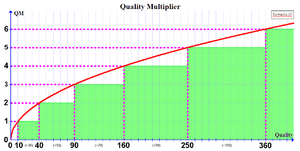Quality
Almost all items, as well as many game-world objects, have a quality factor Q, which may range from 1 to ∞, with a standard default quality for most objects of 10 -- for example, all natural-growing trees are Q10. In general, higher Q items are simply better: high Q weapons do more damage, for example.
The in-game effects vary from item to item, with some items like buckets not having any effect at all. Where quality matters, it usually takes the form of the quality multiplier QM:
It is a nonlinear increase, which means that it becomes harder to get to the next multiplier for higher multipliers. Since Q10 has a QM of 1x, in many places on this wiki you will just see stats given for Q10 objects. You should assume this unless the wiki page you're reading says otherwise.
To make higher-Q objects, you should use higher-Q materials with higher-Q tools.
It is very common for crafting qualities to be softcapped by a crafting skill or a vital stat. For example, if you have a Q40 bone and a Q10 bough, you can in principle make a Q25 bone saw -- but if your survival skill is lower, perhaps at 15, you will only make a Q20 bone saw.
Fractional qualities always to be rounded down to the nearest integer.
Other things in game like Attributes function the same, for instance the way Constitution affects your max hitpoints scales like quality. 10 CON = 100 MHP, 40 CON = 200 MHP, 1000 CON = 1000 MHP.
Rule of thumb:
Q10 = x1 stats
Q40 = x2 stats
Q90 = x3 stats
Q160 = x4 stats
Q250 = x5 stats
Q360 = x6 stats
Q490 = x7 stats
Q640 = x8 stats
Q810 = x9 stats
Q1000 = x10 stats
Examples:
A Q10 Apple gives 0.5 CON, a Q10 Bronze Sword deals 90 damage, a Q10 Boar Tusk Helmet has 1/7 armor class.
A Q40 Apple would give 1 CON.
A Q160 Boar Tusk Helmet would have a 4/28 armor class.
A Q640 Bronze Sword would deal 720 damage.
General Effects
Food
The FEPs given by a piece of food get multiplied by QM. So, for example, a Q10 beetroot gives 0.5 PER and 0.2 CHA, but a Q90 beetroot will give 1.5 PER and 0.6 CHA.
Quality does not affect the amount of hunger that the food restores -- just the amount that it buffs up your vital stats.
There is use for low quality foods, as they can be eaten for FEP Reduction as the FEPs given relative to higher quality foods can be negligible at higher levels.
Curiosity
The LP given by a curiosity get multiplied by QM.
Quality does not affect the amount of Experience that consume and Intelligence it required.
Craft
Calculate items used:
If there's a tool involved:
If there are skill values through involved:
- Calculations will be made in order of top to down.
- For more detailed information look on related pages, not every tool or item follow this rules.
Gear
Weapon
Armor Defense given by a piece of gear = .
Bonus Stats from rings, shirts, masks, gilded gear, etc = .
Ability/Attribute
When two or more Abilities/Attributes is factored in the output quality (for an example, gathering Rock Crystal), the formula is the geometric means of the combined stat numbers
Examples:
Notes
From loftar
For buildable objects, the quality is almost always calculated as such:
- The qualities of items in the individual item types are averaged arithmetically.
- The resulting average qualities of the various types are also averaged arithmetically -- often with some weights on items that should be "obviously" more important (like the iron in iron plows) -- to create the quality of the built object.
For craftable items, most are calculated like this:
- As with buildable object, the qualities of the individual item types are averaged, and then weighted together based on importance.
- If one is using any tools, like a churn, anvil, or smithy's hammer, the qualities of those are averaged with the above resultant quality -- often with a weigth of 1/4 for the tool.
- If any character attributes are involved, those attributes themselves are averaged geometrically, and if the resultant "skill quality" is lower than the "input/tool quality", the resultant quality is the arithmetic average of the skill quality and the input/tool quality.
If you don't know what a geometric average is, it is the multiplication product of the individual values, raised to the power of the inverse of the number of values. In other words, averaging values geometrically means calculating .
As for ovens, kilns, smelter and finery forges, the quality of the resultant quality is the arithmetic average of the input item quality and the average of the oven quality and fuel quality, where the fuel quality is the arithmetic average of the fuel items put into the oven. In other words, if the item quality is , the oven's quality is and the fuel's quality is , the quality of the resulting item will be .
As for the skills involved in crafting, it should mostly be obvious, but there are, of course, a few things to clarify:
- Sewing related recipes (including leatherworking ones) use the Sewing and Dexterity values.
- Smithing related recipes often combine both Smithing and Strength.











![{\displaystyle QualityCap(3stats)={\sqrt[{3}]{Stat_{1}*Stat_{2}*Stat_{3}}}}](https://en.wikipedia.org/api/rest_v1/media/math/render/svg/069de258fedb96728f0209dab254cbc76c1eb434)





